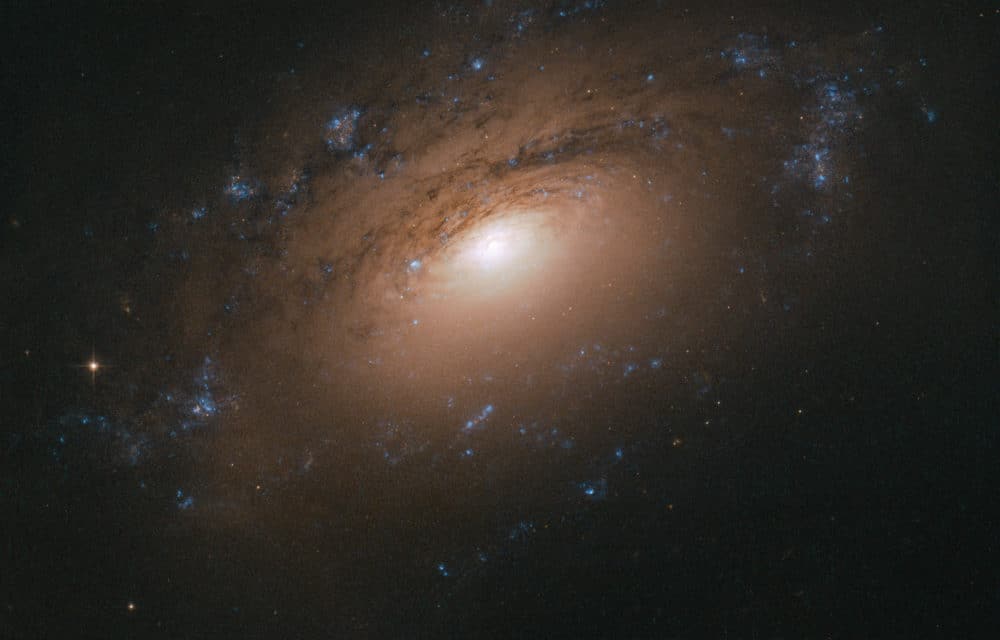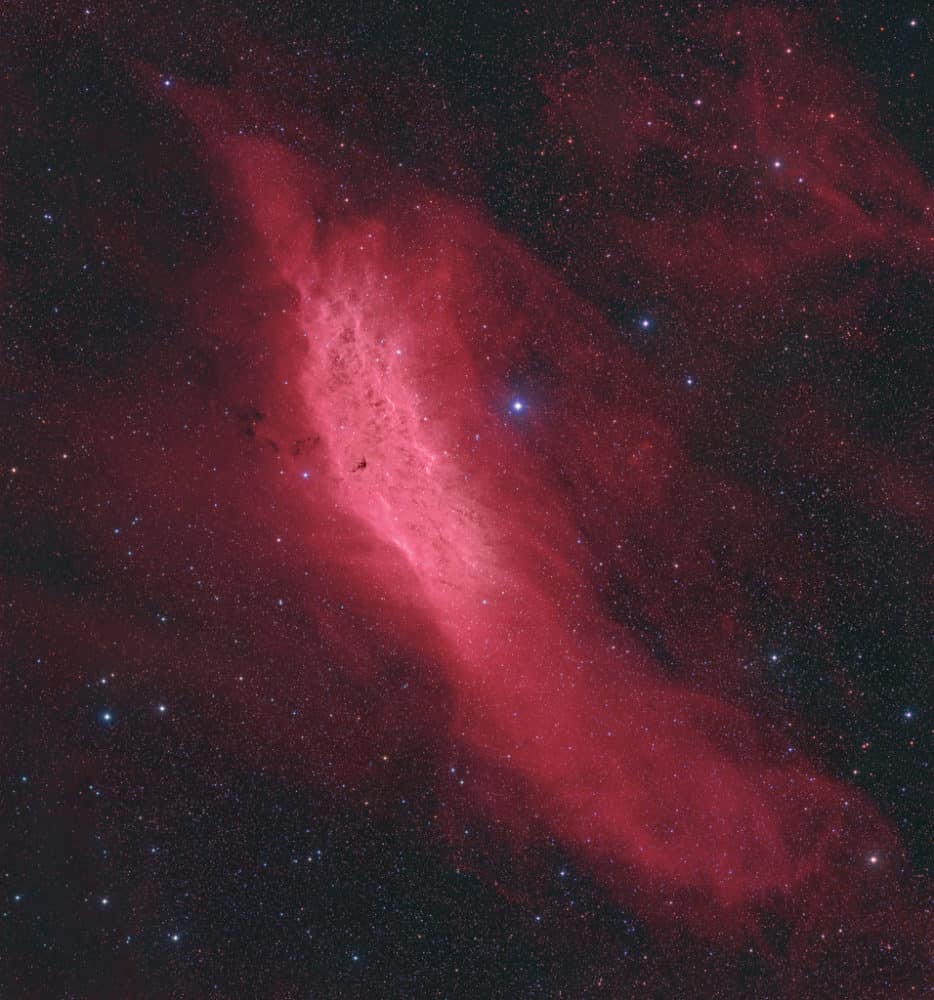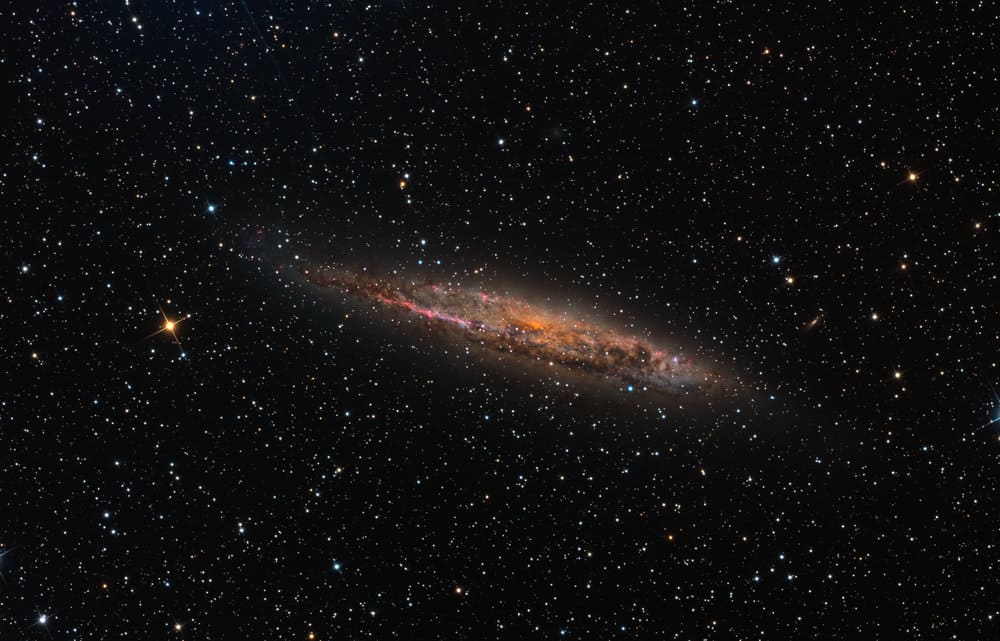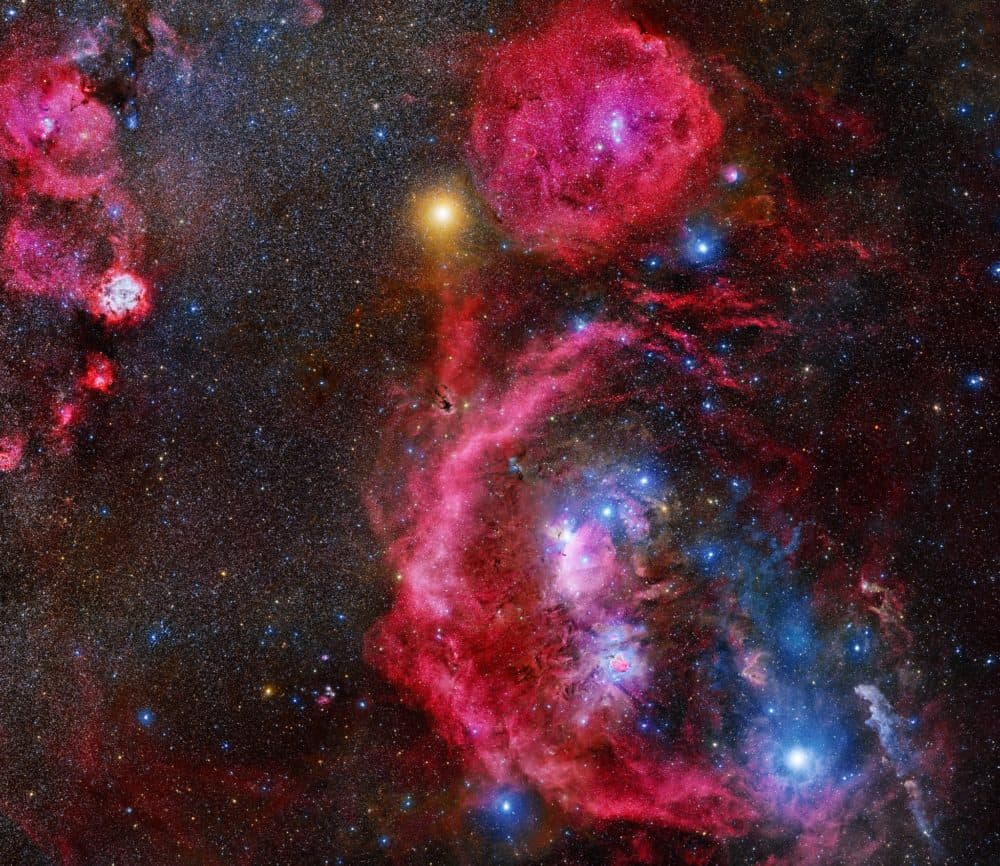Blog
NGC 3169 is located approximately 76 million light-years away in the constellation of Sextans.Also known as LEDA 29855 or UGC 5525, the spiral galaxy was discovered by the German-born British astronomer William Herschel in 1783.NGC 3169 is a member of the Leo I Group of galaxies, which is part of a larger galactic congregation known as the Virgo Supercluster.The galaxy is located relatively close to another spiral galaxy, NGC 3166.The distance between them is just 50,000 light-years, a separation that is only about half the diameter of our Milky Way Galaxy.The two comprise a physical pair and influence each other gravitationally. NGC 3169’s arms, shining bright with big, young, blue stars, have been teased apart, and lots of luminous gas has been drawn out from its disk. The galaxy’s bright center is encircled by thick dust lanes. “Cosmic dust comprises a potpourri of particles, including water ice, hydrocarbons, silicates, and other solid material,” Hubble astronomers said. “It has many origins and sources, from the leftovers of star and planet formation to molecules modified over millions of years by interactions with starlight.”
more...Oteil Burbridge is an American multi-instrumentalist, specializing on the bass guitar, trained in playing jazz and classical music from an early age. He has achieved fame primarily on bass guitar during the resurgence of the Allman Brothers Band from 1997 through 2014, and as a founding member of the band Dead & Company. Burbridge was also a founding member of The Aquarium Rescue Unit, and has worked with other musicians including Bruce Hampton, Trey Anastasio, Page McConnell, Bill Kreutzmann and The Derek Trucks Band, with whom his brother Kofi Burbridge was the keyboardist and flautist.
Burbridge has been recognized for his ability to incorporate scat-singing into his improvised bass solos. Burbridge endorses Fodera, Modulus, Sukop and Dunlop guitars and effects. Burbridge was born and raised in Washington, D.C., to an African American family with some Egyptian heritage. His name, Oteil, means “explorer” or “wanderer”. When he and elder sibling Kofi showed talent for music, their mother encouraged them with classical and jazz courses hoping to nurture their musical inclinations and keep them out of trouble. Kofi remembers Oteil’s first drum set: a Quaker Oatmeal box, when he was only three or four years old. Both brothers were introduced to a wide variety of instruments, and became multi-instrumentalists, with both being taught to play the piano. Oteil gained proficiency on the bass clarinet, violin,and trumpet; however, bass guitar and drums became his instruments of choice (while Kofi developed a love for both flute and keyboards).
John Cipollina (August 24, 1943 – May 29, 1989) was a guitarist best known for his role as a founder and the lead guitarist of the prominent San Francisco rock band Quicksilver Messenger Service. After leaving Quicksilver he formed the band Copperhead, was a member of the San Francisco All Stars and later played with numerous other bands, including Janis Joplin on the Dick Cavett show. Born in Berkeley, California in 1943, Cipollina attended Tamalpais High School, in Mill Valley, California (as did his brother, Mario, born 1954) and sister, Antonia (born 1952). Their father, Gino, was a realtor, and their mother, Evelyn, and godfather José Iturbi, were concert pianists.
John showed great promise as a classical pianist in his youth, but his father gave him a guitar when he was 12 and this quickly became his primary instrument. Cipollina had a unique guitar sound, mixing solid state and valve amplifiers as early as 1965. He is considered one of the fathers of the San Francisco psychedelic rock sound. To create his distinctive guitar sound, Cipollina developed a one-of-a-kind amplifier stack. His Gibson SG guitars had two pickups, one for bass and one for treble. The bass pickup fed into two Standel bass amps on the bottom of the stack, each equipped with two 15-inch speakers. The treble pickups fed two Fender amps: a Fender Twin Reverb and a Fender Dual Showman that drove six Wurlitzer horns.
more...Arthur William “Big Boy” Crudup (August 24, 1905 – March 28, 1974) was an American Delta blues singer, songwriter and guitarist. He is best known, outside blues circles, for his songs “That’s All Right” (1946), “My Baby Left Me” and “So Glad You’re Mine”, later recorded by Elvis Presleyand other artists.
Crudup was born in Forest, Mississippi, to a family of migrant workers traveling through the South and Midwest. The family returned to Mississippi in 1926, where he sang gospel music. He had lessons with a local bluesman, whose name was Papa Harvey, and later he was able to play in dance halls and cafes around Forest. Around 1940 he went to Chicago. He began his career as a blues singer around Clarksdale, Mississippi. As a member of the Harmonizing Four, he visited Chicago in 1939. He stayed in Chicago to work as a solo musician but barely made a living as a street singer. The record producer Lester Melrose allegedly found him while Crudup was living in a packing crate, introduced him to Tampa Red and signed him to a recording contract with RCA Victor‘s Bluebird label. He recorded with RCA in the late 1940s and with Ace Records, Checker Records and Trumpet Records in the early 1950s. He toured black clubs in the South, sometimes playing with Sonny Boy Williamson II and Elmore James.[4] He also recorded under the names Elmer James and Percy Lee Crudup. His songs “Mean Old ‘Frisco Blues”, “Who’s Been Foolin’ You” and “That’s All Right” were popular in the South.[5] These and his other songs “Rock Me Mama”, “So Glad You’re Mine”, and “My Baby Left Me” have been recorded by many artists, including Elvis Presley, Slade, Elton John and Rod Stewart.
more...Tanzania
more...https://www.youtube.com/watch?v=dgCUzw4_65c
more...Drifting through the Orion Arm of the spiral Milky Way Galaxy, this cosmic cloud by chance echoes the outline of California on the west coast of the United States. Our own Sun also lies within the Milky Way’s Orion Arm, only about 1,500 light-years from the California Nebula. Also known as NGC 1499, the classic emission nebula is around 100 light-years long. The California Nebula shines with the telltale reddish glow characteristic of hydrogen atoms recombining with long lost electrons. The electrons have been stripped away, ionized by energetic starlight. Most likely providing the energetic starlight that ionizes much of the nebular gas is the bright, hot, bluish star Xi Persei just to the right of the nebula. A popular target for astrophotographers, this deep California Nebula image is a 6 panel telecopic mosaic and covers a wide field of view. The nebula lies toward the constellation Perseus, not far from the Pleiades.
more...Robert Michael Watson Jr. (born August 23, 1953), known professionally as Bobby Watson, is an American saxophonist, composer, and educator.
Watson was born in Lawrence, Kansas and grew up in Kansas City, Kansas. He attended the University of Miami at the same time as Pat Metheny, Jaco Pastorius, and Bruce Hornsby. He graduated in 1975, moved to New York City, and became music director for the Jazz Messengers from 1977 to 1981. After leaving the band, he was productive as a session musician, recording with Wynton Marsalis, Branford Marsalis, Max Roach, Joe Williams, Dianne Reeves, Lou Rawls, Betty Carter, and Carmen Lundy. He formed the band Bobby Watson & Horizon with bassist Curtis Lundy and drummer Victor Lewis, with whom he played throughout the 1980s and ’90s.
Watson led a group known as the High Court of Swing (a tribute to the music of Johnny Hodges), the sixteen-piece Tailor-Made Big Band, and is a founding member of the 29th Street Saxophone Quartet, an all-horn, four-piece group with alto saxophonist Ed Jackson, tenor saxophonist Rich Rothenberg, and baritone saxophonist Jim Hartog. Watson also composed a song for the soundtrack to the movie A Bronx Tale (1993).
A resident of New York for most of his professional life, he served as a member of the adjunct faculty and taught saxophone privately at William Paterson University from 1985 to 1986 and the Manhattan School of Music from 1996 to 1999. He is involved with the Thelonious Monk Institute‘s annual Jazz in America high school outreach program.
more...Terje Rypdal (born 23 August 1947) is a Norwegian guitarist and composer. He has been an important member in the Norwegian jazz community, and has also given show concerts with guitarists Ronni Le Tekrø and Mads Eriksen as “N3”.Rypdal was born in Oslo, the son of a composer and orchestra leader. He studied classical piano and trumpet as a child, and then taught himself to play guitar as he entered his teens. Starting out as a Hank Marvin-influenced rock guitarist with The Vanguards, Rypdal turned towards jazz in 1968 and joined Jan Garbarek‘s group and later George Russell‘s sextet and orchestra. An important step towards international attention was his participation in the free jazz festival in Baden-Baden, Germany, in 1969, where he was part of a band led by Lester Bowie. During his musical studies at Oslo university and conservatory, he led the orchestra of the Norwegian version of the musical Hair. He has often been recorded on the ECM record label, both jazz-oriented material and classical compositions (some of which do not feature Rypdal’s guitar).
Keith John Moon (23 August 1946 – 7 September 1978) was an English drummer for the rock band the Who. He was noted for his unique style and his eccentric, often self-destructive behaviour. His drumming continues to be praised by critics and musicians. He was posthumously inducted into the Modern Drummer Hall of Fame in 1982, becoming only the second rock drummer to be chosen, and in 2011, Moon was voted the second-greatest drummer in history by a Rolling Stone readers’ poll.
Moon grew up in Alperton, a suburb of Wembley, in Middlesex, and took up the drums during the early 1960s. After playing with a local band, the Beachcombers, he joined the Who in 1964 before they recorded their first single. Moon remained with the band during their rise to fame, and was quickly recognised for his drumming style, which emphasised tom-toms, cymbal crashes, and drum fills. Throughout Moon’s tenure with the Who his drum kit steadily grew in size, and along with Ginger Baker, Moon has been credited as one of the earliest rock drummers to regularly employ double bass drums in his setup. He occasionally collaborated with other musicians and later appeared in films, but considered playing in the Who his primary occupation and remained a member of the band until his death. In addition to his talent as a drummer, however, Moon developed a reputation for smashing his kit on stage and destroying hotel rooms on tour. He was fascinated by blowing up toilets with cherry bombs or dynamite, and by destroying television sets. Moon enjoyed touring and socialising, and became bored and restless when the Who were inactive. His 21st birthday party in Flint, Michigan, has been cited as a notorious example of decadent behaviour by rock groups.
Moon suffered a number of setbacks during the 1970s, most notably the accidental death of chauffeur Neil Boland and the breakdown of his marriage. He became addicted to alcohol, particularly brandy and champagne, and acquired a reputation for decadence and dark humour; his nickname was “Moon the Loon”. After moving to Los Angeles with personal assistant Peter “Dougal” Butler during the mid-1970s, Moon recorded his only solo album, the poorly received Two Sides of the Moon. While touring with the Who, on several occasions he passed out on stage and was hospitalised. By their final tour with him in 1976, and particularly during production of The Kids Are Alright and Who Are You, the drummer’s deterioration was evident. Moon moved back to London in 1978, dying in September of that year from an overdose of Heminevrin, a drug intended to treat or prevent symptoms of alcohol withdrawal.
https://www.youtube.com/watch?v=vCupJpymgfE
more...Alvin Gilbert “Gil” Coggins (August 23, 1928 – February 15, 2004) was an American jazz pianist.
Coggins was born to parents of West Indian heritage. His mother was a pianist and had her son start on piano from an early age. He attended school in New York City and Barbados. In Harlem, New York City, he attended The High School of Music & Art.
In 1946, Coggins met Miles Davis while stationed at Jefferson Barracks in Missouri. After his discharge he began playing piano professionally, working with Davis on several of his Blue Note and Prestige releases. Coggins also recorded with John Coltrane, Sonny Rollins, Lester Young, Art Blakey‘s Jazz Messengers, Ray Draper, and Jackie McLean.
Coggins gave up playing jazz professionally in 1954 and took up a career in real estate, playing music only occasionally. He did not record as a leader until 1990, when Interplay Records released Gil’s Mood. He continued performing through the 1990s and 2000s until 2004, when he died from complications sustained in a car crash eight months earlier in Forest Hills, New York. Better Late Than Never, his second album recorded as a leader, was released posthumously.
more...Flamenco Fridays featuring Solearas. Soleares (plural of soleá, pronounced [soleˈa]) is one of the most basic forms or palos of Flamenco music, probably originated around Cádiz or Seville in Andalusia, the most southern region of Spain. It is usually accompanied by one guitar only, in phrygian mode “por arriba” (fundamental on the 6th string); “Bulerías por soleá” is usually played “por medio” (fundamental on the 5th string). Soleares is sometimes called “mother of palos” although it is not the oldest one (e.g. siguiriyas is older than soleares) and not even related to every other palo (e.g. fandangos family is from a different origin).
Soléa develops in (altered) Phrygian mode “por arriba” (fundamental on the 6th string), with the III degree of the mode altered to a major 3rd when resolving to I.
To adapt to the singer’s vocal range, guitarists can use a “cejilla” (capo) to play in any key while preserving the known chord positions. Modern guitarists often play soleá using other chord positions or even changing the tuning of the guitar to experiment with new sounds, especially in solo instrumental pieces.
The typical flamenco progression iv, III, II, I (an altered Phrygian cadence) is heard several times during the development of the song. In E altered Phrygian, the progression would be Am, G, F, E (the E chord should be Em in a diatonic Phrygian cadence, but its diatonic third – G – is altered to a G♯).
more...
https://www.youtube.com/watch?v=nMkShK-cqsw
more...Large spiral galaxy NGC 4945 is seen edge-on near the center of this cosmic galaxy portrait. In fact, it’s almost the size of ourMilky Way Galaxy. NGC 4945’s own dusty disk, young blue star clusters, and pink star forming regions standout in the sharp, colorful telescopic image. About 13 million light-years distant toward the expansive southern constellation Centaurus, NGC 4945 is only about six times farther away than Andromeda, the nearest large spiral galaxy to the Milky Way. Though this galaxy’s central region is largely hidden from view for optical telescopes, X-ray and infrared observations indicate significant high energy emission and star formation in the core of NGC 4945. Its obscured but active nucleus qualifies the gorgeous island universe as a Seyfert galaxy and home to a central supermassive black hole.
more...Malachi Favors (August 22, 1927–January 30, 2004) was an American jazz bassist who played with the Art Ensemble of Chicago.
“Favors’s tendency to dissemble about his age was a well-known source of mirth to fellow musicians of his generation”. Most reference works give his year of birth of 1937, but, following his death, his daughter stated that it was 1927.
Favors primarily played the double bass, but also played the electric bass guitar, banjo, zither, gong, and other instruments. He began playing double bass at the age of 15 and began performing professionally upon graduating high school. Early performances included work with Dizzy Gillespie and Freddie Hubbard. By 1965, he was a founder of the Association for the Advancement of Creative Musicians and a member of Muhal Richard Abrams‘ Experimental Band.
more...John Lee Hooker (August 22, 1917– June 21, 2001) was an American blues singer, songwriter, and guitarist. The son of a sharecropper, he rose to prominence performing an electric guitar-style adaptation of Delta blues. Hooker often incorporated other elements, including talking bluesand early North Mississippi Hill country blues. He developed his own driving-rhythm boogie style, distinct from the 1930s–1940s piano-derived boogie-woogie.
Some of his best known songs include “Boogie Chillen’” (1948), “Crawling King Snake” (1949), “Dimples” (1956), “Boom Boom” (1962), and “One Bourbon, One Scotch, One Beer” (1966). Several of his later albums, including The Healer (1989), Mr. Lucky (1991), Chill Out (1995), and Don’t Look Back (1997), were album chart successes in the U.S. and U.K. The Healer (for the song “I’m In The Mood”) and Chill Out (for the album) both earned him Grammy wins as well as Don’t Look Back, which went on to earn him a double-Grammy win for Best Traditional Blues Recording and Best Pop Collaboration with Vocals (with Van Morrison).
Hooker’s date of birth is a subject of debate; the years 1912, 1915, 1917, 1920, and 1923 have been suggested. Most sources give 1917, though at times Hooker stated he was born in 1920. Information in the 1920 and 1930 censuses indicates that he was born in 1912. In 2017, a series of events took place to celebrate the purported centenary of his birth. In the 1920 federal census, John Hooker is seven years old and one of nine children living with William and Minnie Hooker in Tutwiler Mississippi.
more...(Achille) Claude Debussy (French: [aʃil klod dəbysi]; 22 August 1862 – 25 March 1918) was a French composer. He is sometimes seen as the first Impressionist composer, although he vigorously rejected the term. He was among the most influential composers of the late 19th and early 20th centuries.
Born to a family of modest means and little cultural involvement, Debussy showed enough musical talent to be admitted at the age of ten to France’s leading music college, the Conservatoire de Paris. He originally studied the piano, but found his vocation in innovative composition, despite the disapproval of the Conservatoire’s conservative professors. He took many years to develop his mature style, and was nearly 40 when he achieved international fame in 1902 with the only opera he completed, Pelléas et Mélisande.
Debussy’s orchestral works include Prélude à l’après-midi d’un faune (1894), Nocturnes (1897–1899) and Images (1905–1912). His music was to a considerable extent a reaction against Wagner and the German musical tradition. He regarded the classical symphony as obsolete and sought an alternative in his “symphonic sketches”, La mer (1903–1905). His piano works include two books of Préludes and two of Études. Throughout his career he wrote mélodies based on a wide variety of poetry, including his own. He was greatly influenced by the Symbolist poetic movement of the later 19th century. A small number of works, including the early La Damoiselle élue and the late Le Martyre de saint Sébastien have important parts for chorus. In his final years, he focused on chamber music, completing three of six planned sonatas for different combinations of instruments.
With early influences including Russian and far-eastern music, Debussy developed his own style of harmony and orchestral colouring, derided – and unsuccessfully resisted – by much of the musical establishment of the day. His works have strongly influenced a wide range of composers including Béla Bartók, Olivier Messiaen, George Benjamin, and the jazz pianist and composer Bill Evans. Debussy died from cancer at his home in Paris at the age of 55 after a composing career of a little more than 30 years.
more...The constellation of Orion is much more than three stars in a row. It is a direction in space that is rich with impressive nebulas. To better appreciate this well-known swath of sky, an extremely long exposurewas taken over many clear nights in 2013 and 2014. After 212 hours of camera time and an additional year of processing, the featured 1400-exposure collage spanning over 40 times the angular diameter of the Moonemerged. Of the many interesting details that have become visible, one that particularly draws the eye is Barnard’s Loop, the bright red circular filament arcing down from the middle. The Rosette Nebula is not the giant red nebula near the top of the image — that is a larger but lesser known nebula known as Lambda Orionis. The Rosette Nebula is visible, though: it is the red and white nebula on the upper left. The bright orange star just above the frame center is Betelgeuse, while the bright blue star on the lower right is Rigel. Other famous nebulas visible include the Witch Head Nebula, the Flame Nebula, the Fox Fur Nebula, and, if you know just where to look, the comparatively small Horsehead Nebula. About those famous three stars that cross the belt of Orion the Hunter — in this busy frame they can be hard to locate, but a discerning eye will find them just below and to the right of the image center.
more...More Posts
- Daily Roots with Joe Gibbs & The Professionals
- The Cosmos with NGC 2359
- Santana
- Charles Tyler
- Ernie Wilkins
- World Music with Evritiki Zygia
- Daily Roots with Augustus Pablo
- The Cosmos with Sh2-132
- Keith Godchaux
- Commander Cody
- Phil Upchurch
- Carmell Jones
- Bobby Bradford
- World Music with Kasai Masai
- Daily Roots with Yabby You
- HAIR Sunday Matinee 7-18-21
- The Cosmos with M31
- Dudu Pakwana
- Papa Dee Allen
- Tatá Güines



